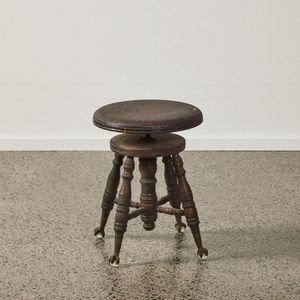A 19th century American adjustable stool, with metal eagle claw…
A 19th century American adjustable stool, with metal eagle claw feet on glass balls and a heavy patina. Lowest height 48 cm, depth 36 cm, max height approx. 61 cm
You must be a subscriber, and be logged in to view price and dealer details.
Subscribe Now to view actual auction price for this item
When you subscribe, you have the option of setting the currency in which to display prices to $Au, $US, $NZ or Stg.
This item has been sold, and the description, image and price are for reference purposes only.
- Patination / Patina - In broad terms, patination refers to the exterior surface appearance of the timber, the effect of fading caused by exposure to sunlight and air over the course of a century or more, changing the piece to a soft, mellow colour.
As patina is very difficult to replicate, it is one of the most important guides to determining the age of furniture.
Patina is also the term applied to the bloom or film found on old bronzes due to oxidisation. - Claw Feet - Carved or cast in the shape of a lion's claw or the talons of other more fabulous beasts. They may be found on chair and table legs, supporting platform bases, and cabinets in the Classical Revival manner. Claw feet are not uncommon on Australian furniture made throughout the 1850s and 1860s, though, as with all forms of carving, the deeper and richer the claws are carved, the earlier the piece is likely to be.
- The Eagle - The eagle has been a symbol of power, victory, and strength for centuries. It is often associated with bravery, prowess, and dominance, and has been used as a symbol by many cultures and civilizations throughout history.
In ancient Greece, the eagle was associated with the god Zeus, who was considered the king of the gods and the ruler of the skies. In many cultures, the eagle was seen as a messenger between the physical world and the spirit world, and was associated with the sun and the sky.
In the Roman Empire, the eagle was the symbol of the Roman army, and was displayed on the standards of the soldiers to show the power and authority of the empire. In medieval Europe, the eagle was used as a symbol of power and victory by monarchs and rulers, and was often depicted in art and architecture as a symbol of strength and courage.
In modern times, the eagle continues to be a symbol of power, victory, and strength. It is often used as a symbol by nations and organisations, and is frequently depicted in art and on monuments to commemorate important events and achievements.
The eagle's powerful appearance, combined with its association with freedom, courage, and dominance, makes it a popular and enduring symbol of power and victory.
This item has been included into following indexes:
